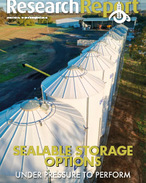This article is 8 years old. Images might not display.
Researchers are evaluating the latest technology and animal behaviour software algorithms used to automatically deliver daily data on individual animal performance, including growth rates, fertility, pregnancy status, parentage and date of calving.
They are also looking to broader-scale cooperation, through more integrated data systems using emerging technologies such as Blockchain to support industry-wide goals such as genetic breeding values and enhanced marketing strategies.
Telstra CEO Andrew Penn was present for updates on a pivotal PhD research project by Don Menzies, which was backed by a Telstra scholarship.
Drawing on his extensive beef industry background knowledge, Mr Menzies has been trialling automated data systems to identify maternal parentage, fertility and calving events.
Menzies has been able to report on the potential of Walk-over-Weighing (WoW) and radiolocation ear tag technology, including automated calving devices.
CQUniversity’s Precision Livestock Management (PLM) team is now exploring the optimal configuration for an end-to-end autonomous livestock management system.
“We wish to leverage the technologies, computational capabilities and communications to deliver decisions to boost the profitability of the beef industry, particularly in northern Australia,” said CQUniversity Provost Professor Helen Huntly.
“We want to use our research to underpin practical solutions and ensure that practical technology results in profitable outcomes for our graziers.”
Penn confirmed Telstra would fund a fresh PhD research scholarship valued at $75,000 over three years to help CQUni explore the interconnection of data systems in livestock businesses.
Telstra’s new scholarship holder will also scope the potential for localised, in-field sensor data processing to yield more efficient data transfer within low bandwidth systems in rural and remote locations.
CQUniversity’s Professor Dave Swain said the PLM team is well advanced in deploying autonomous livestock monitoring systems and developing a range of behavioural-based algorithms derived from fixed location sensors at watering points and on-animal sensors.
“Our next phase will provide a platform to enhance the value chain, providing greater information and direct feedback between consumers and producers,” Professor Swain said.























